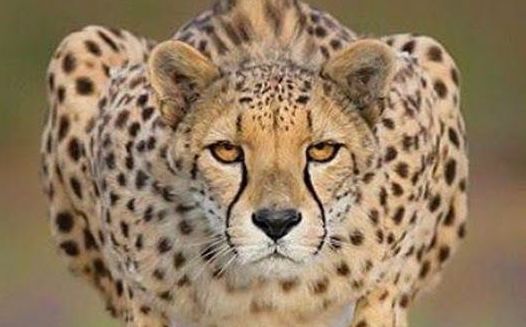The cheetah is built for high speed over short distances. It is similar in size to the leopard but much slimmer and rangier. The cheetah has a deep chest and lanky legs. The tail is long for balance but about one half the body and head length. The background colour varies from “tawny to grayish-white to bright rufus fawn” but is generally yellow with white undersides. The photograph by Martin Heigan below shows the solid black spots that are evenly spaced throughout and unique to each cheetah. The texture of the fur is said to vary. The spots are soft and the background harsher to the touch.

Cheetah Speed and cheetah description are bound together because this wild cat has many anatomical adaptations to increase speed that alters its appearance and function. Adaptations for speed require special focus when describing the appearance. The tail length is such that it is an important anatomical feature which aids in balance by acting like a rudder. The cheetah needs this precision in balancing because they have to chase at high speed, twisting and turning to catch fast prey animals.
Anatomy designed for speed:
- Claws – these are “half-retractable. They are “shorter and straighter” than
for other cats and there are no claw sheaths. They aid grip when running and turning. - Teeth – the upper and lower canine teeth are relatively small. This allows
for enlarged nasal openings facilitating air intake, which in turn supports bursts of high-speed running. - Tail – this is long as mentioned to aid balance when changing direction quickly while chasing prey.
- Flexibility – the cheetah’s clavicle (collar bone) is small and joined to the scapula (shoulder blade) by ligaments. There is no bony connection between scapula and body. This aids flexibility which in turn aids speed through an enlarged stride but it works against efficiency. The spine is also very flexible.
- Legs – large thigh muscles and long legs.
- Paws – small, the webbing (skin between digits) is less than for other cats allowing the toes to spread wider. The paw pads have ridges running lengthwise that act like the patterned soles of training shoes that aid grip1.
RELATED: cheetah speed for more on why this cat species is the world’s fastest land animal.

The fur is short except at the nape (the back of the neck) and shoulders, which is a mane of sorts – a vestige from when an adult was a cub. The whiskers are short too. Whiskers in domestic cats are important but less sofor the cheetah. The tail is spotted with the last third sometimes banded. As is the case for some other wildcats, melanistic or black cheetahs have been rarely seen. There are records of partially albino cheetahs and white cheetahs. A white cheetah has blue spots on a “whitish-blue coat”1. The king cheetah (Acinonyx rex) is a cheetah with a slightly different pattern caused by a recessive gene that produces what cat fanciers call a “blotched tabby” pattern or classic tabby pattern. They are rare cheetahs and found exclusively in Zimbabwe, Botswana and the Transvaal. Read more on the king cheetah (see picture below).
The skull has a broad “highly domed forehead”. The skulls bones are thin and light in contrast to that of the lion and tiger. As a result, the muscles are short resulting in a reduced bite force. The cheetah kills by strangulation using the throat bite and its teeth are not ideally made for a bite to the spinal cord or neck bite. There are two noticeable dark lines running down either side of the face. Their function might be to reduce glare into the eyes.

The cheetah weighs from about 36 to 65 kilograms (79 – 140 lbs). The combined head and body length is from about 115 to 135 centimeters long (45 – 53 inches). Its height to shoulder is 67 to 94 centimetres (26 – 37 inches). Males are slightly larger than females1.
There are two variant forms of the cheetah: the woolly cheetah and the king cheetah. At one time they were considered as separate species of cat but now they are seen as no more than isolated mutants or at best local sub-species according to Dr. Desmond Morris. The king cheetah is simply a variant due to a genetic mutation. The blackspots merge to create blobs. There is a picture of this below.

Cheetah Description – Notes:
Source: Wild Cats of the World by Mel and Fiona Sunquist pages 19-34.

